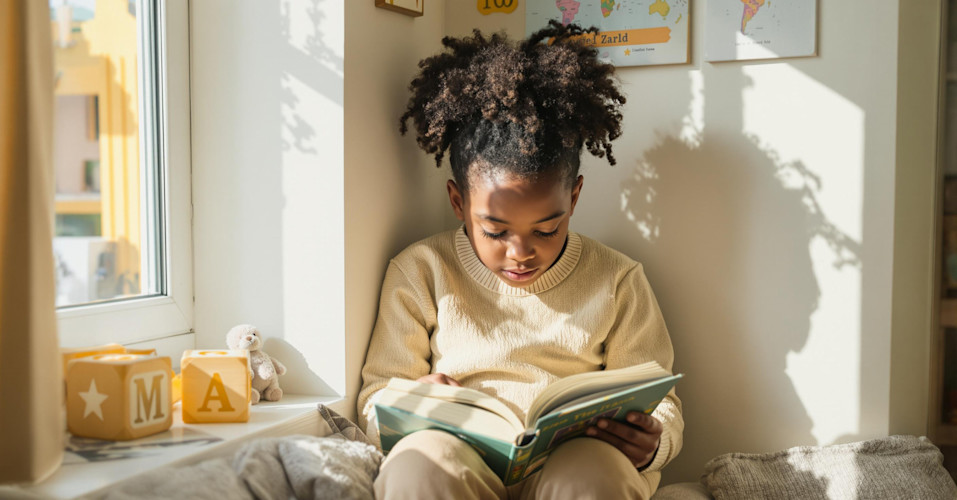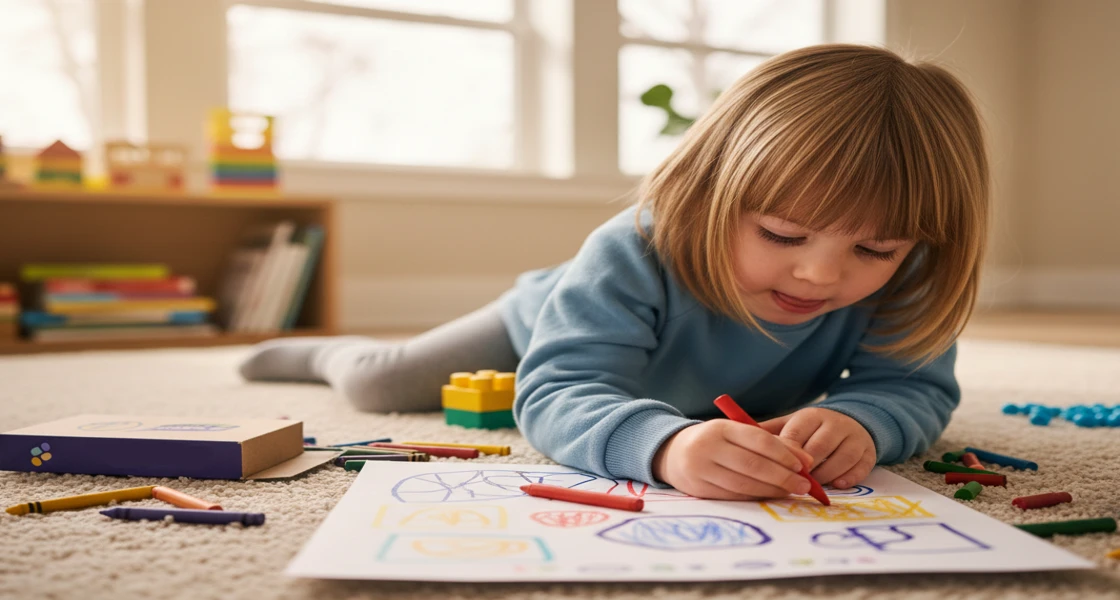What do Mark Twain, Agatha Christie, and Maya Angelou all have in common?
They became bestselling authors without any formal education in creative writing. What they did have was a strong sense of voice, a bold imagination, and the freedom to explore their ideas without fear of being “wrong.”
And that’s precisely the spirit we want to nurture in young writers.
Creative writing should be a place where kids can stretch their imagination, play with wild ideas, and express what matters to them. It’s not about perfect punctuation—it’s about creating something they’re excited to share.
At Outschool, we see what happens when kids are given the space to write freely. In this article, we’ll share creative ways to help your child fall in love with writing—using stories, play, everyday conversations, and even screen time as a springboard for their imagination.
Start with a spark not a page
There are very few things less inspiring than a blank page, and that’s why young learners find them so intimidating. To get your learner into the groove of writing, try to understand what makes them want to write.
Think dinosaurs, superheroes, animals, space missions—anything that holds their curiosity for a long period is a good place to start. Once you’ve got them interested in the subject that they’re writing about, nudge them forward with simple prompts that will keep them thinking.
For example, if your learner is into rocks, ask them to write about the superpowers they associate with each rock. Or if you’re a pet owner, ask your learner to imagine what your pet would say if they could talk. The idea is to get them thinking freely before diving into the nuances of language.
Try storytelling before formal writing
Once your learner starts thinking more freely, it might be a good time to gently introduce the idea of shaping those thoughts into a story. This isn’t about spelling or sentence structure just yet—it’s more about exploring how their ideas connect. What happens first? What comes next? Who’s involved, and why?
This stage is really about planting the seeds of storytelling. Here are a few fun, practical ways to teach storytelling:
- Act out scenes with toys or puppets to explore character, emotion, and cause-and-effect.
- Draw a comic strip or simple storyboard to help map out the beginning, middle, and end of a story.
- Record your learner telling a story aloud—then pause together to talk through what might come next before writing it down.
- Use open-ended prompts like "What would happen if your character lost their powers?" or "What happens when the door creaks open?" to spark plot development.
- Play a "build-a-story" game where each person adds one sentence at a time, helping learners practice pacing and build momentum.
- Encourage them to use props, voice changes, or even simple costumes to bring their characters to life—this deepens their understanding of dialogue and motivation.
These tools help learners begin to understand pacing, character motivation, and how ideas connect—all before they face the pressure of spelling, structure, or grammar. It's a bridge between imagination and written expression.
Use movies, shows, and music to get ideas flowing
We’ve all been told to read more—and reading is great—but it’s not the only medium that can spark creativity. Movies, TV shows, audiobooks, and music are all great alternatives to get ideas flowing.
Here are some simple ways you can turn screentime into creative goldmines:
- Mute a favorite show and let your learner invent the dialogue. You can take turns voicing characters, which helps develop their sense of timing and tone.
- Help your child write from their favorite character's point of view - like a diary entry or letter. For example, our Star Wars creative writing class shows how familiar characters can inspire amazing original stories.
- Create a new ending for a well-loved movie or show. You can brainstorm alternate plot twists together or ask, "What if the villain turned good halfway through?"
- Listen to instrumental music or songs without lyrics and ask, "What story does this sound like?" They might imagine a journey, a mystery, or a celebration.
- Watch a short video clip and pause it halfway. Invite your learner to write what they think happens next, or rewrite the whole scene with their own spin.
These activities use the media your child already loves as a creative playground. The familiarity lowers the pressure, and the storytelling possibilities are endless.
Make writing time short, sweet, and consistent
As your learner begins exploring storytelling, it can help to carve out little pockets of time where creativity can flourish—without a formal lesson plan. Some of the best story ideas pop up in everyday moments: while you're driving, waiting in line, or winding down for bed.
Here are some ideas to try:
- Write a letter from your pet’s point of view: What did they do today? What do they secretly think about the vacuum?
- Invent a silly law for your town: "On Thursdays, everyone must wear mismatched socks."
- Make up a recipe for an alien planet: What ingredients grow there? How does it taste?
- Create a superhero identity using only objects you see in the room.
- Describe a magical door and what your learner thinks is behind it.
- Set a timer for 10 minutes and co-create a mini story where each of you writes one sentence at a time.
These 10–20-minute writing adventures keep things flexible and fun. You can even turn them into rituals: a dinner-table story challenge, a carpool "what if" game, or a shared bedtime prompt.
Introduce writing concepts slowly
In the early stages, creative writing is less about punctuation and paragraph structure, and more about giving space to explore big ideas, bold voices, and bursts of imagination.
As your learner grows more confident and comfortable with expressing their ideas, you can begin to gently introduce concepts—but in a way that still feels creative and supportive. Think of it as building a flexible framework that helps shape their stories without limiting their imagination.
Here are a few ways to ease into this:
- Talk about story arcs: Ask about the beginning, middle, and end of a story. Who is the main character? What challenge do they face? How do things change?
- Use visual aids: A story mountain or comic strip can help learners map out rising action and resolution.
- Try sentence starters: Phrases like "Suddenly..." or "Meanwhile..." can help add movement and flow.
- Break it down: One day might be about describing the setting, another about building dialogue or exploring emotion.
- Analyze favorite stories: Read a short book together and talk about what made it interesting or surprising.
The goal isn’t to enforce rules—it’s to offer tools that help your learner better express the stories they already want to tell. Start small, stay curious, and let structure support their creativity.
Progressing on to advanced writing techniques
As your learner progresses through the basics of storytelling and writing, you can start to introduce them to literary techniques that will evolve their craft. But this can still be done without a formal setting, the trick is letting them use the tool before naming the concept.
Here’s how to introduce deeper writing tools through exploration first:
- Encourage sound-rich descriptions: Ask them to write a scene where the setting is full of sounds, without mentioning that they’re using onomatopoeia. Let them discover how "crunch," or "pop," brings a scene to life.
- Let comparison come naturally: Prompt them to describe a character's emotions through an image. Afterward, introduce the idea of a metaphor or simile and show them what they just created.
- Play with poetic forms as creative constraints: Try a haiku or an acrostic poem just for fun. It’s a great way to introduce rhythm, structure, and word choice without it feeling like a grammar lesson.
- Reflect emotion through setting: Invite them to write about a stormy afternoon or a bright, breezy morning—and then explore how that atmosphere might mirror a character’s inner world. That’s when you can explain a concept like pathetic fallacy.
- Build prompts around a technique: Without naming it upfront, ask them to write a story that includes five vivid sounds or a setting that matches a character's mood. Afterward, talk about their literary techniques—often without even knowing it.
- Analyze the media around you: Highlight scenes in a movie, a paragraph in a book, or a song lyrics that use these techniques to make the writing rich. Invite your learner to explore how a certain technique makes the media they like so well done.
By starting with the creative experience and naming the technique afterward, learners build an intuitive feel for how language works. It keeps writing fun and expressive, while gently layering in depth for those ready to take things further.
Let them choose how to share their work
One of the key benefits of teaching creative writing comes from giving young writers the power. Not every writer wants to stand up and perform their story—and that’s more than okay. In fact, some of the most meaningful storytelling happens quietly. Give your child the freedom to choose how (or if) they want to share what they’ve created. That might look like:
- Reading their story at bedtime to a sibling or caregiver
- Turning it into a comic or illustrated book with captions
- Recording it as an audio story or podcast-style "narration"
The key is offering options that feel safe, creative, and fun. Gentle, low-pressure opportunities to share, like reading a favorite sentence aloud or swapping feedback with a trusted peer, can help kids begin to take ownership of their work. When learners have the freedom to decide how and when to share, they often feel more confident and proud of what they've created.
Keep the vibe kind and judgment-free
The best creative writing happens when kids feel safe to take creative risks without worrying about being "right." And let’s be honest—most adults today still aren’t equipped to handle criticism, especially when it comes to something as personal as creative expression. So for your learner, this can be doubly hard.
Instead of focusing on what could be improved, highlight what stands out. Maybe it’s the twist they added at the end, a funny moment that made you laugh, or a character that feels so real you can picture them. Ask questions that show you’re interested, like: "What inspired this part of your story?" or "Tell me more about how that character came to life."
When kids feel genuinely listened to, their confidence grows—and so does their writing. They begin to understand that their words have power and that their voice is worth developing. Writing becomes less about performance and more about expression.
Explore creative writing classes for extra support
A supportive learning community can make all the difference—especially as learners grow more curious and ready to stretch their creative skills. Writing classes aren’t just about practice; they’re about confidence, connection, and learning how to build something meaningful from that first spark of an idea.
Outschool’s small-group writing classes give learners the chance to explore new techniques in a supportive environment. Classes often begin with open-ended prompts and guided play, then gradually introduce structure through activities like character mapping, dialogue practice, and collaborative storytelling.
As learners share their work, they start to see writing as a conversation, not just a solo project. With the help of expert teachers, they learn how to give and receive feedback in ways that feel encouraging, not intimidating. They also get to revise with intention—spotting the moments that could use more detail or clarity, and learning how to shape their draft without losing their original voice.
For kids who are especially eager, or ready for deeper writing tools, personalized sessions and themed classes help them dive into everything from poetic forms to world-building.
Common questions about teaching creative writing
You’ve got the ideas flowing, the stories unfolding—but what happens when your child says, "I don’t know what to write," or starts feeling stuck? That’s where a few thoughtful strategies (and some real-life reassurance) can go a long way. Let’s dive into a few of the questions we hear most often from parents who want to make writing feel joyful, doable, and a little more magical.
How does creative writing support my child's growth?
Creative writing opens amazing doors for your child's development! Beyond building strong communication skills, it boosts confidence, sparks imagination, and helps develop empathy. Kids who love writing often shine in other subjects too, as they learn to express their ideas clearly and think outside the box.
When is the perfect time to start creative writing?
Every child discovers writing at their own perfect time, just like learning to walk or talk. Many kids start telling stories through pictures and words around age 4-5, but the most important thing is keeping it playful and pressure-free.
My child feels nervous about writing. How can I help?
Start with these gentle stepping stones to build confidence:
- Draw pictures first, then add simple words
- Record their spoken stories and help write them down
- Play word games that make writing feel like fun
- Break writing into tiny, manageable chunks
Outschool's resources for helping struggling writers offer more supportive strategies to make writing feel less overwhelming.
My child loves video games but isn't excited about writing. Any tips?
Use their passion for gaming as a springboard for writing! Video games make heavy use of storytelling and world-building, so you can use that to engage your learner in these creative ways:
- Write new endings for their favorite games
- Create character backstories
- Design and describe new game levels
- Write game reviews or strategy guides
In fact, our creative writing classes often use popular games as jumping-off points for stories, so that could also be a medium for you to explore.
Where can I find inspiration and support for teaching writing?
You’ve got lots of wonderful options when it comes to inspiration and support. Your local library might host writing clubs or storytelling workshops, and community centers often have creative programs kids can join. At home, try turning dinner time into a storytelling circle or start a shared writing journal that you and your learner can pass back and forth.
Encouraging budding writers
Creative writing is more than just a language skill—it’s a way for kids to explore who they are and how they see the world. It helps them process emotions, sharpen their voice, and build a stronger sense of self. And the more freedom and joy you can bring to the process, the more they’ll grow—not just as writers, but as thinkers and communicators.
If your learner seems ready for a little more guidance or community, you might consider joining a live, small-group writing class—like the ones offered on Outschool. These sessions are designed to keep the spirit of creativity intact while helping young writers grow their skills in a natural, encouraging environment.


.svg)
.svg)







